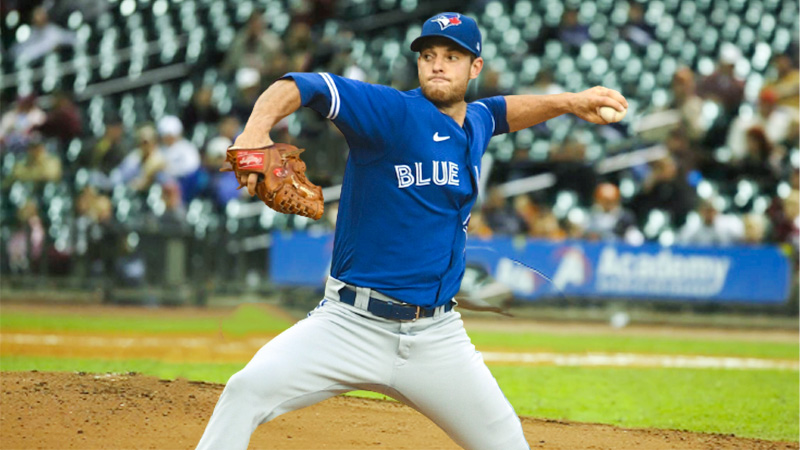In the world of baseball, mastering a variety of pitches is essential for pitchers looking to outwit and overpower opposing hitters. Among the repertoire of pitches available to pitchers, one stands out for its ability to induce ground balls, weaken contact, and keep batters off balance—the sinker.
The sinker, also known as a two-seam fastball, is a pitch renowned for its hard downward movement as it approaches the plate.
In this guide, we will delve into the intricacies of the sinker pitch, exploring its definition, characteristics, and benefits. So, join us as we explore the world of the sinker and discover how this powerful pitch can elevate your game on the mound.
What Is the Sinker Pitch?
When it comes to pitching in baseball, one of the most effective pitches in inducing ground balls and weak contact is the sinker. The sinker is a type of fastball that is known for its hard downward movement as it approaches the plate.
In this section, we will explore the definition of a sinker pitch and discuss its distinguishing characteristics. We will also delve into how the sinker differs from other fastball variations, providing a clear understanding of this unique pitch.
A Sinker Pitch and Its Characteristics
A sinker pitch, also known as a two-seam fastball, is thrown with a specific grip and release point to create downward movement. Unlike a traditional four-seam fastball that typically travels on a straight path, the sinker is designed to dive or “sink” as it approaches the hitter.
This sinking action makes it difficult for the batter to make solid contact, often resulting in ground balls or swings and misses.
To achieve the sinking movement, pitchers grip the baseball using a modified two-seam grip. This grip involves slightly offsetting the index and middle fingers towards the inside of the seams.
By holding the ball deep in the hand and applying firm pressure with the fingertips, pitchers can generate the necessary spin and downward force on the pitch.
Differentiating Sinkers From Other Fastball Variations
While sinkers and four-seam fastballs are both classified as fastballs, they have distinct characteristics that set them apart. The primary difference lies in the movement they produce.
A sinker is designed to have significant downward movement, whereas a four-seam fastball typically travels on a straighter path with minimal movement.
Furthermore, the grip and release points for a sinker differ from those of a four-seam fastball. A four-seamer is thrown with a four-seam grip, where the fingers are aligned along the seams.
In contrast, a sinker requires a modified two-seam grip, with the fingers slightly offset towards the inside of the seams. This grip, combined with the proper release point, enables pitchers to generate the desired sinking action.
It’s important to note that other fastball variations, such as cutters or split-finger fastballs, may exhibit movement differently from a sinker. While these pitches can be effective in their own right, the sinker stands out for its unique ability to induce ground balls and weak contact.
Benefits of Throwing a Sinker

The sinker pitch offers several significant benefits for pitchers who incorporate it into their repertoire. From inducing ground balls and double plays to limiting extra-base hits, the sinker can be a game-changer on the mound.
In this section, we will explore the key advantages of throwing a sinker and how it can positively impact a pitcher’s performance.
Inducing Ground Balls and Double Plays
One of the primary benefits of a well-executed sinker is its ability to induce ground balls. The downward movement of the pitch, coupled with its late-breaking action, causes hitters to make contact with the top half of the baseball.
As a result, the ball is more likely to be hit into the ground, increasing the chances of outs being recorded.
Furthermore, when there are runners on base, the sinker can be particularly effective in generating double plays.
Due to its downward movement, hitters often make contact with the pitch on the lower half of the baseball, leading to weakly hit ground balls that are ideal for initiating a double play sequence.
Generating Weak Contact and Limiting Extra-base Hits
Another advantage of the sinker is its ability to generate weak contact from opposing hitters. The sinking action of the pitch causes the baseball to lose velocity and induce off-balance swings, resulting in less solid contact.
This, in turn, leads to a higher probability of infield pop-ups, dribblers, or slow rollers that are easier for fielders to handle.
Moreover, the sinking movement of the pitch can help limit extra-base hits. By inducing ground balls, the sinker decreases the likelihood of hard-line drives or fly balls that could result in extra bases for the hitter.
This can be particularly advantageous in tight game situations or when facing power hitters who thrive on driving the ball into the gaps.
Keeping the Ball Down in the Strike Zone
The sinker’s natural movement also allows pitchers to keep the ball down in the strike zone. By working the lower portion of the zone, pitchers can induce more ground balls and weak contact, as hitters often struggle to lift the ball against the downward trajectory of the pitch.
This ability to consistently locate the sinker low in the zone adds another layer of effectiveness and unpredictability to a pitcher’s repertoire.
Additionally, by keeping the ball down, pitchers reduce the risk of leaving pitches up in the zone, where hitters have a better chance of making solid contact. This can lead to fewer home runs and extra-base hits, helping to minimize the damage inflicted by opposing offenses.
The sinker pitch offers numerous benefits to pitchers. From inducing ground balls and double plays to generating weak contact and limiting extra-base hits, the sinker can be a highly effective tool for achieving success on the mound.
By mastering the mechanics and command of the sinker, pitchers can enhance their ability to control the game and keep opposing hitters off balance.
How to Throw A Sinker Pitch
Here are only 3 steps to follow to learn to throw a Sinker Pitch:
Step 1: Grip and Finger Placement
The grip and finger placement are crucial components of throwing a successful sinker pitch. They determine how the ball will behave and the amount of movement it will generate.
In this section, we will explore the modified two-seam grip commonly used for sinkers, discuss other grip variations, and highlight the importance of finger pressure and wrist action in achieving optimal sinker movement.
The modified two-seam grip is the foundation of the sinker pitch. To achieve this grip, position the baseball deep in your hand, with your fingertips resting on the seams.
While the modified two-seam grip is the most common grip for sinkers, pitchers may experiment with slight variations based on personal comfort and hand size.
Some pitchers might prefer to place their fingers closer to the outside of the seams, while others may experiment with different finger placements to enhance movement or control.
Finger pressure and wrist action are crucial elements in executing an effective sinker pitch. To generate optimal movement, focus on applying firm pressure with your fingertips on the baseball during the delivery.
Step 2: Arm Action and Release Point
The arm action and release point are vital aspects of throwing a successful sinker pitch. They contribute to the desired downward movement and control of the pitch.
When throwing a sinker, it’s crucial to maintain a consistent arm angle that aligns with your regular fastball delivery. Consistency in arm angle helps disguise the pitch and prevents hitters from picking up any visual cues that may give away the sinking action.
Whether you use an over-the-top, three-quarter, or sidearm delivery, strive to replicate the arm angle you typically use for your fastball.
To achieve the desired downward movement, focus on the mechanics of your delivery. A key factor is the position of your forearm and hand at release.
As your arm comes through the throwing motion, keep your forearm in a vertical position with your hand behind the baseball. This position allows you to generate the necessary backspin that contributes to the sinking action.
Releasing the ball out in front of your body is crucial for maximizing the sinker’s effectiveness. By releasing the ball in front of you, you ensure that it has the opportunity to travel on its desired downward trajectory toward the plate.
Regular practice, attention to detail, and feedback from coaches or instructors will help you refine these aspects of your delivery and maximize the effectiveness of your sinker.
Step 3: Developing Command and Movement
Developing command and movement with your sinker pitch is crucial for its effectiveness on the mound.
Like any other pitch, mastering the sinker requires dedicated practice and repetition. Regular bullpen sessions, simulated game situations, and live batting practice will help you develop muscle memory and feel for the pitch.
Consistency in mechanics is crucial for generating a consistent sink with your pitch. Pay attention to the alignment of your body, the position of your arm, and the timing of your release. Work on maintaining a repeatable delivery and replicating your arm action and release point.
A key aspect of developing a consistent sink is finding the right balance between control and aggression. Avoid over-gripping the ball or trying to force excessive movement.
To achieve the desired movement with your sinker, be open to making minor adjustments to your grip and release. Experiment with subtle variations to find the grip and finger pressure that
With consistent practice and a focus on fine-tuning mechanics and grip, you can elevate your sinker to become a highly effective weapon in your pitching arsenal.
Tips for A Successful Sinker Pitch

To maximize the effectiveness of your sinker pitch, it’s important to incorporate it strategically into your pitch sequences, read and adapt to hitter tendencies, and seek guidance from coaches and instructors. In this section, we will explore these tips for success with your sinker.
Incorporating Sinkers Strategically Into Pitch Sequences
When using the sinker, it’s crucial to consider how it complements the other pitches in your repertoire. The sinker can be an effective pitch to induce ground balls and weak contact, but it works best when paired with pitches that create contrast in movement, speed, and location.
Experiment with different pitch sequences to keep hitters off balance. For example, following a high fastball with a well-located sinker low in the zone can catch hitters off guard and induce ground balls.
Mixing in off-speed pitches like changeups or breaking balls alongside your sinker can further disrupt timing and increase the effectiveness of your overall pitch repertoire.
Reading and Adapting to Hitter Tendencies
Effective pitching goes beyond the mechanics of the pitch itself. It involves reading and adapting to hitter tendencies, recognizing their strengths and weaknesses, and adjusting your approach accordingly. Pay attention to how hitters react to your sinker.
Are they consistently getting on top of the pitch and hitting it into the ground? Or are they consistently missing or making weak contact?
Use this information to your advantage. If hitters are consistently hitting ground balls, continue to attack the lower half of the strike zone with your sinker. If they are struggling to make contact or consistently swinging and missing, consider mixing in more sinkers to exploit their vulnerability.
Additionally, be observant of any patterns or adjustments hitters make during the game. If they start timing your sinker well, consider changing the sequencing or mixing in different pitch types to keep them guessing.
Seeking Guidance From Coaches and Instructors
Seeking guidance from experienced coaches and pitching instructors can significantly enhance your development and success with the sinker pitch. They can provide personalized feedback on your mechanics, grip, release point, and overall pitch sequencing.
Their expertise and insights can help you make the necessary adjustments to optimize the movement and effectiveness of your sinker.
Regularly engage in discussions with your coaches and instructors, asking for their observations and suggestions. Take advantage of video analysis and bullpen sessions to fine-tune your mechanics and identify areas for improvement.
Their guidance and expertise will contribute to your growth as a pitcher and help you unlock the full potential of your sinker.
Incorporating sinkers strategically, reading and adapting to hitter tendencies, and seeking guidance from coaches and instructors are crucial tips for success with your sinker pitch.
Mistakes and Troubleshooting in Sinker Pitch
While the sinker pitch can be highly effective, pitchers may encounter certain common mistakes or face challenges with grip, release, sink, or control. In this section, we will address these issues and provide troubleshooting tips to help you overcome them.
Addressing Common Issues With Sinker Grip and Release
- Inconsistent grip: If you find that your sinker lacks consistency or movement, double-check your grip. Ensure that your fingers are properly positioned on the seams with the modified two-seam grip. Make any necessary adjustments to achieve a consistent grip, as even slight variations can affect the sinking action.
- Gripping the ball too tightly: An overly tight grip can hinder movement and control. Relax your grip on the ball and focus on applying firm pressure with your fingertips rather than squeezing the ball. This will allow for a freer release and better-sinking action.
- Inadequate finger pressure: Insufficient pressure with your fingertips can result in a flat sinker lacking movement. Concentrate on firmly pressing your fingertips into the ball during your delivery to maximize spin and generate the desired sinking action.
Troubleshooting Loss of Sink or Control Problems
- Release point inconsistency: If you notice a loss of sink or control with your sinker, check your release point. Releasing the ball too early or too late can impact the movement and accuracy of the pitch. Focus on releasing the ball out in front of your body and consistently releasing it at the desired point in your delivery.
- Mechanical flaws: Poor mechanics, such as an inconsistent arm angle or rushing through your delivery, can lead to sinker problems. Take time to analyze and refine your mechanics, ensuring you maintain a consistent arm angle and execute a smooth, balanced delivery. Work with a pitching coach or instructor to identify and correct any mechanical flaws.
- Lack of lower body engagement: A strong lower body foundation is essential for generating power and control with your sinker. If you’re experiencing issues with sink or control, pay attention to your lower body engagement. Ensure that you are utilizing proper leg drive and incorporating your lower body into your delivery to maximize the effectiveness of your sinker.
Refining Mechanics and Seeking Feedback
- Video analysis: Record your pitching sessions to review and analyze your mechanics. Compare your delivery to that of successful sinker pitchers and identify areas for improvement. Pay attention to your grip, arm action, release point, and lower body mechanics. Video analysis can provide valuable insights and aid in refining your mechanics.
- Coaching and feedback: Seek feedback from experienced coaches, pitching instructors, or teammates. They can provide objective observations and offer suggestions to refine your mechanics and troubleshoot any issues you’re experiencing with your sinker. Embrace their feedback and implement the necessary adjustments to improve your pitch.
- Regular practice and repetition: Consistent practice and repetition are key to refining your sinker pitch. Focus on executing proper mechanics, grip, and release points during bullpen sessions and game-like situations. Regularly work on developing muscle memory and fine-tuning your pitch through dedicated practice.
Remember that troubleshooting and refining your sinker pitch may require time and patience. Stay committed to the process and remain open to adjustments and feedback.
With perseverance, practice, and a willingness to refine your mechanics, you can overcome common mistakes and challenges, and improve the effectiveness of your sinker pitch.
FAQs
Can any pitcher learn to throw a sinker?
Yes, any pitcher can learn to throw a sinker with proper instruction, practice, and dedication. However, the effectiveness of the pitch may vary based on individual mechanics, arm slots, and grip preferences.
How long does it take to master the sinker pitch?
The time it takes to master the sinker pitch varies for each pitcher. It depends on factors such as natural ability, dedication to practice, and the guidance received from coaches or instructors. Consistent practice and repetition are key to developing command and movement with the sinker.
Can I throw a sinker if I already have a fastball and a changeup?
Absolutely! The sinker can be a valuable addition to your pitch repertoire, even if you already throw a fastball and changeup. The sinker offers a different movement and can provide a unique challenge for opposing hitters. Incorporating it strategically alongside your existing pitches can enhance your overall effectiveness as a pitcher.
Should I throw sinkers exclusively or mix them with other pitches?
The decision to throw sinkers exclusively or mix them with other pitches depends on your pitching style, strengths, and game situation. While some pitchers have success primarily relying on the sinker, others prefer to mix it with other pitches to keep hitters off balance. Experimentation and feedback from coaches can help you determine the optimal approach for your pitching arsenal.
Can the sinker be an effective pitch for youth or amateur pitchers?
Yes, the sinker can be effective for youth or amateur pitchers. However, it’s important to prioritize proper mechanics, arm care, and age-appropriate pitch counts to prevent injury. Seeking guidance from experienced coaches and gradually introducing the sinker as pitchers develop can help ensure its effectiveness and safety.
Conclusion
The sinker pitch is a powerful weapon in a pitcher’s arsenal, known for inducing ground balls, weak contact, and limiting extra-base hits.
Throughout this guide, we have explored the grip and finger placement required for a sinker, the importance of arm action and release point in achieving desired movement, and the benefits of developing command and movement with this pitch.
We have also discussed strategic tips for incorporating the sinker into pitch sequences, reading and adapting to hitter tendencies, and seeking guidance from coaches and instructors.
Thank you for your time.







